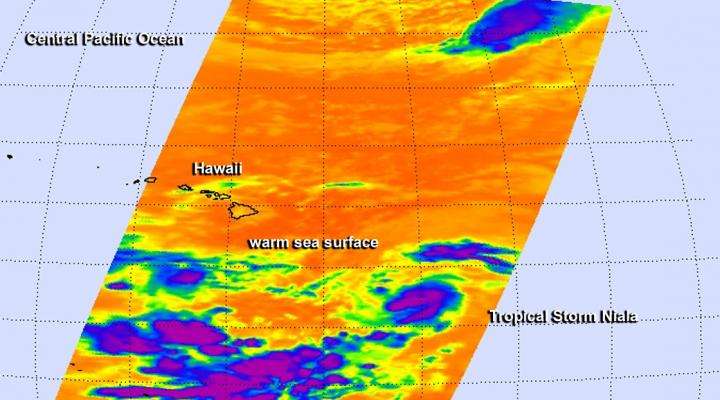NASA sees wind shear affecting Tropical Storm Niala

NASA's Aqua satellite saw wind shear was affecting newborn Tropical Storm Niala as it continued moving through the Central Atlantic Ocean.
Despite wind shear, Tropical Depression 6C formed about 500 miles southeast of Hilo, Hawaii at 11 p.m. EDT on September 24, 2015. By 11 a.m. EDT, the depression strengthened into a tropical storm and was renamed Tropical Storm Niala.
On Sept. 24 at 7:47 a.m. EDT the Atmospheric Infrared Sounder or AIRS instrument aboard NASA's Aqua satellite provided an infrared look at developing Tropical Depression 6C. AIRS data showed that northwesterly vertical wind shear was pushing clouds and strongest storms with coldest cloud tops to the southeast of the center. Cloud top temperatures were as cold as -63 Fahrenheit/-53 Celsius, indicative of strong storms with the potential for heavy rain. The AIRS infrared data also showed that the system was moving through warm waters near 28 to 29 Celsius (82.4 to 84.2 Fahrenheit) which helped it strengthen into a depression and later into a tropical storm.
NOAA's Central Pacific Hurricane Center noted that the most recent guidance from University of Wisconsin-CIMSS and ships for current vertical wind shear in the vicinity of Niala, suggest that there is moderate shear of about 15 knots (17.2 mph/27.8 kph) from the northwest.
At 5 a.m. EDT (0900 UTC) on September 25 the center of Tropical Storm Niala was located near latitude 15.1 north and longitude 150.1 west. That's about 490 miles (790 km) southeast of Hilo, Hawaii. Maximum sustained winds are near 35 knots (40 mph/65 kph) and gradual intensification is expected during the next two days.
NOAA's Central Pacific Hurricane Center noted that Niala was moving toward the northwest near 7 mph (11 kph). TD6C is expected to gradually turn toward the west-northwest then west on Saturday, September 26 and pass far south of the Big Island of Hawaii.
Provided by NASA's Goddard Space Flight Center



















